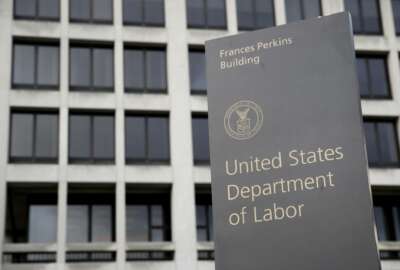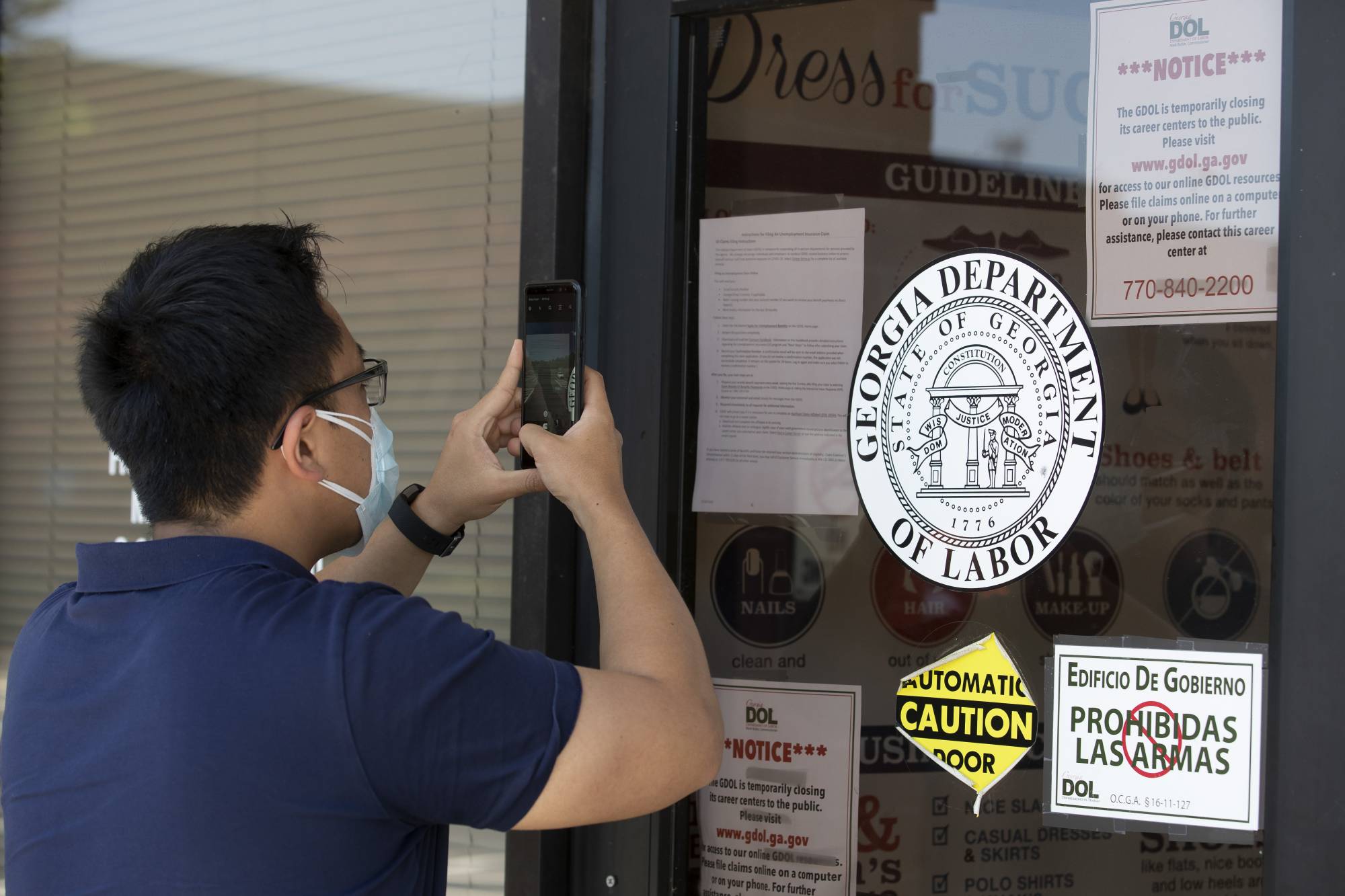How state agencies want to foster more resilient workforces and get them off assistance
Ten states under the auspices of the National Governors Association, have been working on ways to modernize and integrate the delivery of services to the...
Best listening experience is on Chrome, Firefox or Safari. Subscribe to Federal Drive’s daily audio interviews on Apple Podcasts or PodcastOne.
Unemployment insurance has been a crucial safety net for the past couple of years. Now some state agencies have been trying to devise programs that lead to more resilient local workforces with a focus on reemployment. Ten states under the auspices of the National Governors Association, have been working on ways to modernize and integrate the delivery of services to the unemployed. For more on the Workforce Innovation Network, the association’s Program Director Rachael Stephens spoke to Federal Drive with Tom Temin.
Interview transcript:
Tom Temin: Ms. Stephens, good to have you on.
Rachael Stephens: Thanks so much, Tom. It’s great to be on with you.
Tom Temin: All right, tell us about this network, Workforce Innovation Network. Which 10 states and what are they doing here?
Rachael Stephens: Thanks so much for having me on to talk about this. This is an initiative we and our members at NGA are really excited about and just for your audience for quick background if they don’t know about the National Governors Association, NGA is the nation’s only bipartisan membership organization representing many of the nation’s governors among our 55 states and territories. And the NGA Center for Best Practices where I work is kind of the consulting and research arm of NGA. And we’re the only group doing what we do in direct support of governors and their state executives across really a wide range of policy areas, from health to public safety, to cybersecurity, to infrastructure. And my team and I have the pleasure of supporting governors around workforce development and economic policy. At NGA, we not only get to work with governors and state leaders, we also have a vast network of partners in the private sector, national organizations, think tanks, researchers, subject matter experts, practitioners of all sorts. So through the Workforce Innovation Network, what we wanted to do was, stepping back to 2020, and really the worst of the pandemic for states where they were dealing with around the unemployment crisis, we wanted to find a way to pull all of these resources, all this information, all these ideas together to help governors and their executive leaders across a number of agencies, think about how they could really better support the workforce in that moment, while also still taking a long view and thinking about the future. We knew that once the worst was over, there were still a lot of bigger picture systemic economy wide challenges that governors have been thinking about, before the pandemic, that we wanted to help them have a space to think about even in the midst of the worst of it all.
Tom Temin: So 10 states then received grants from NGA from your fundraising of $100,000. And what was their charge to do with that money?
Rachael Stephens: Yeah, so we actually were able to fundraise with partners from the Cognizant Foundation to start us out. And we got 10 states on board, those first 10 states were Alabama, Arizona, Colorado, Hawaii, Illinois, Maine, Missouri, Nevada, New Mexico and Washington. And I think that was even in alphabetical order. Those 10 states were really charged, they came to us looking for an opportunity to learn from experts, from the private sector, from each other, about promising strategies to really improve coordinated service delivery through the workforce system. So when people who are unemployed or looking for a better job are coming into public workforce programs in their local areas, they might need other supports and services, as well as those training supports those reemployment assistance services. And we wanted to make sure states had mechanisms and systems in place to actually help connect people to all the many things they may need to ultimately truly get back on their feet, rather than kind of remaining, kind of churning through that system and really struggling to find a good job.
Tom Temin: In other words, that people thrown on to unemployment many, perhaps for the first time and didn’t know their way around those mechanisms that might be available. And there’s so many programs and so many states, I don’t think anyone can name them all. But to kind of get those before people’s eyes, so to speak, so that they simply didn’t linger on unemployment?
Rachael Stephens: Absolutely. And it goes even deeper than that. We did a number of states work on improving kind of what I would call it one-stop service delivery portals, if you will, with so many people needing to access services, virtually, they also were looking to better connect people who were coming in person to receive services or who would be once stores were reopened as they are now in many cases. And there’s also a lot that goes on behind the scenes, you have to be able to blend or braid different funding streams. As you’ve pointed out with so many different federal, state and local programs, you have to be able to connect data sources and information to make sure you’re really understanding how people are flowing through these different programs and systems and that you’re really meeting their needs. There’s a lot that goes into it to create what might hopefully for a person seem like ultimately, the goal here is for it to seem like a really seamless experience to get what they need.
Tom Temin: We’re speaking with Rachael Stephens, she’s program director for Workforce Development and Economic Policy at the National Governors Association. So you’ve got a couple of issues here, I guess. One is just the sheer technology of blending these programs and the federal government is also bad at it. They’ve got that no wrong front door idea that they’re trying to develop at the federal level so people can navigate the government. But then you’ve also got all of these rules that apply to the programs and especially if the money comes ultimately from the federal government, sometimes there are hundreds, thousands, literally, pages of rules. Is that the kind of challenge that the governors and their agencies face?
Rachael Stephens: Well, I’m glad you mentioned it. It certainly is and through the Workforce Innovation Network, our work with states was really to help them navigate and innovate within the sort of constraints they’re facing, and hopefully with additional support that they can either pull in from outside government sources. However, all this work like much of our work across the NGA Center for Best Practices, does inform what we do as an organization as a membership organization to support our members and identifying bipartisan areas of agreement around what needs to change at the federal level. For your listeners, I would point out last year, our governors voted on principles to renew the federal workforce system. And those are available on our website. These are really high level principles that are intended to serve as a guidepost for legislators, administration officials, as they’re implementing new programs considering new legislation, or even reauthorizing existing legislation, as we know, is hopefully coming up at some point next year. So among those priorities, you’ll see a lot of themes kind of relating to what you just pointed out. Opportunities for governors to really leverage their leadership and their role within this ecosystem, opportunities for states to have kind of flexible resources to hopefully truly innovate and not just spend limited resources kind of on basics of administration and compliance with rules and regulations and evaluations, and also really ability to invest in creative pilots, rigorous evaluations of those pilots, and really being able to just truly meet the innovation demand that’s out there and engage employers and education partners in that process as well. So again, a lot of principles kind of laid out there at a high level. But again, really, really thinking about how this work all connects to what’s needed at the federal level to make more good work, like what these 10 states were able to accomplish even more possible and scalable in other areas.
Tom Temin: And do we know yet what types of programs states have come up with to meet these goals of integration and one-stop shopping and so on?
Rachael Stephens: It’s perfect timing for you to ask that. I actually also just realized the network is just hitting its one-year birthday around right now. We launched in January 2021. And our first cohort of 10 states have been working really hard. We had a five month kind of innovation action planning period with them last year. And they’re now working with some of our partners in the Workforce Innovation Network to really implement those plans and develop new programs and strategies. And we just released a publication just a couple weeks ago, called [“Lessons Learned In Workforce Innovation: How Ten Governors Are Redesigning Workforce Systems For Better Employment Outcomes.“] And that also is available online. And that highlights some of our key lessons learned from this work through 10 states, what are some strategies and big takeaways other states can take from what these 10 states have done so far and use in their own systems? And we also featured case studies, a case study of every single state among those 10, that kind of gives you an overview of what they’ve done, and how it’s helping. And so we’ve got great initiatives highlighted there from again, that whole list of 10 states, the Alabama Skills-Based Recovery Initiative is certainly one to be excited about. To the point you’re just talking about, and kind of that one-stop sort of platform for folks to enter into the system and the range of services available, Hawaii’s career acceleration navigator, really looking into that one-stop virtual service delivery hub. Another phenomenal case study among the 10 in there. So I definitely encourage your listeners to take a look.
Tom Temin: And I guess each state is so different. When you talk about Hawaii, if you’re going to stay in Hawaii, and you’re going to work, you’ve got to do the work that’s in Hawaii, whereas other states are contiguous to other states. And they may have more local resources. So that sounds like the totality of these programs has to be tailored for each state’s economic and industrial situation.
Rachael Stephens: That’s definitely the case. I’ll actually start by not exactly contradicting and building on something you pointed out, which is kind of the nature of needing to be really focused on what’s around you in terms of the job opportunities available. Absolutely true in many areas. And really leveraging your local networks and resources and employers and educational institutions is an incredibly valuable part of all these strategies. However, as we saw during the pandemic, and it’s more true now than it was before the pandemic, there’s a lot of opportunities out there for remote work. And that’s actually something that places like Hawaii, as well as a lot of rural communities in the contiguous United States are really trying to capitalize on. This connects, of course, to broadband expansion strategies, and a lot of those resources and states will be looking to implement here in the near future. But it also connects to kind of, in Hawaii’s case, as an example, a strategy to connect people virtually with services and resources, and with hopefully online training programs, and maybe even jobs that are online. So Hawaii can retain its workforce, and its talent, keep people in Hawaii and keep people in these communities, while hopefully allowing them the ability to access great jobs that don’t require them to be on site. And I would say that’s something we know a lot of rural regions, again in states and regions across America are looking at now.
Tom Temin: So it sounds like there is lessons here for the federal agencies to take a look at too, say labor, commerce and a few others.
Rachael Stephens: I would absolutely say so and at NGA we’re very fortunate. We get to have great working relationships with many of these agencies, really all of them across the presidential administrations and right now it’s no different. And so we’re able to communicate what we’re learning from some of these programs and what our members priorities are as a result up to our partners at the federal level, which is really exciting, especially right now as they’re considering and developing so many new programs and opportunities for states.
Tom Temin: Alright. So you’ve done 10 states or 10 states have done this project. What is ahead here?
Rachael Stephens: I’m really glad that you asked. We are really excited to have a second cohort of states now working with us on a connected but slightly different subject. We’re now working with North Carolina, North Dakota, Oklahoma, Pennsylvania, Rhode Island and Hawaii joining us again after that first project to focus on digital skill development and really closing digital skill gaps and digital equity gaps in their states. So just like this Lessons Learned document we just shared we are going to be working our more than 20 national subject matter expert partners that are part of the network as well as additional supporters from Intel, Microsoft, Walmart and Western Governors University are supporting this work with states to deliver additional lessons learned, hopefully to our broader networks. So maybe we can talk again in a few months later on this year once we have those.
Tom Temin: Alright, we’ll look forward to that Rachael Stephens is program director for Workforce Development and Economic Policy at the National Governors Association. Thanks so much for joining me.
Rachael Stephens: Thanks so much, Tom. It’s a pleasure talking with you.
Copyright © 2025 Federal News Network. All rights reserved. This website is not intended for users located within the European Economic Area.
Tom Temin is host of the Federal Drive and has been providing insight on federal technology and management issues for more than 30 years.
Follow @tteminWFED






